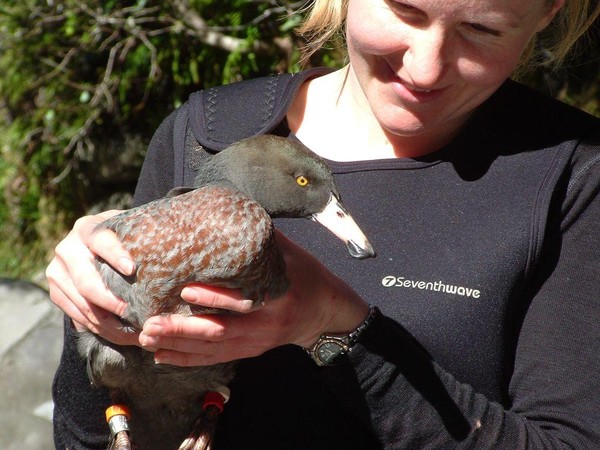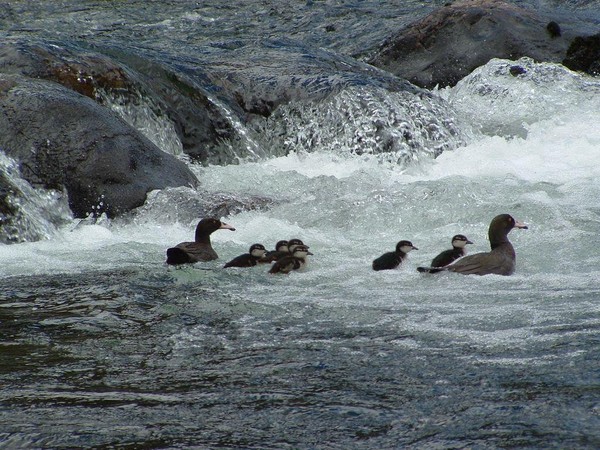Protecting Whio in Tongariro Forest
Tuesday 2 March 2010, 11:10AM
By Central North Island Blue Duck Trust
890 views

This month [March] is Whio Awareness Month. The whio, or blue duck, is one of New Zealand’s most endangered birds.
The Awareness Month aims to increase public knowledge about the whio’s plight. It is an initiative of the Central North Island Blue Duck Charitable Trust, which was established in 2002 to enhance, protect and promote the whio.
Unlike other native New Zealand birds, such as the kiwi or the kakapo, the whio cannot be shifted to predator-free offshore islands because of their unique habitat. This makes it much more difficult to protect them and to increase their numbers.
With the help from funding from the Trust, a five year intensive population monitoring and predator control programme was launched by the Department of Conservation in 2004. The results of this programme have been so successful that funding has been allocated for another five year period.
“Loss of habitat and reduced water quality are seen as some of the major causes for the decline in whio numbers, but the biggest problem facing the local whio is predation, mainly by stoats and other introduced species such as feral cats, dogs and ferrets and to a lesser extent rats and possums,” says DoC Ranger, Alison Beath.
As part of DoC’s work, ten sites around the country have been designated as ‘security sites’, and predator control has been carried out.
Alison and her DoC colleagues, Bubs Smith and Dean Flavell, have carried out the monitoring during this time and they are thrilled with the progress they have seen, particularly in the Tongariro Forest Area.
“The first two years of the programme involved monitoring the Mangatepopo, Upper Whanganui and Whakapapa rivers to get accurate information on the population numbers of breeding pairs and chicks, hatching and fledging. Ducks were caught and colour banded to be able to identify individuals and follow their fates.”
In 2006, areas adjacent to both the Whakapapa and Mangatepopo rivers had aerial 1080 drops.
“Blue Duck are specialist aquatic insect feeders, and have no curiosity for novel items of food, so aren’t tempted to eat the 1080 pellets. No whio were found to have died of 1080 poisoning in the drop area”.
In fact the 1080 drop had a very positive impact of the whio population, with the number of chicks hatching doubled. This was due to 1080 killing predators such as stoats and rats.
In the fourth year of the programme, predator trapping started for the first time on the rivers, with remarkable results.
Alison admits that initially she was sceptical of the success of trapping. “I thought it would be a lot of work for not much gain, but thankfully I was proven wrong.”
Alison says that, prior to any predator control, they considered it a ‘good year’ if 25 chicks were born. “After we started trapping this number soared – and we had 86 chicks hatch in one year! It was just amazing to see how well the combination of predator control tools, both 1080 and trapping really worked”.
The success of the programme in the Tongariro Forest Area has been a big boost for the local whio populations. This year there have been an additional 42 pairs recorded in the trapped river sections of Tongariro Forest. The aim is to get 50 breeding pairs at each site within 10 years.
Alison says it’s also really important for people to be aware of the impact they can have on whio.
“Another cause of disturbance is the increasing use of the rivers by humans for recreation like, fishing, rafting / kayaking and hunting. The extent of this disturbance is still a bit of an unknown, but there is some evidence that humans can unknowingly separate family groups resulting in duckling deaths. Dogs will also kill or disturb nesting ducks. Because of this, DoC tries to encourage these user groups to stay out of the rivers particularly when there are likely to be young broods on the river (September – December).”
